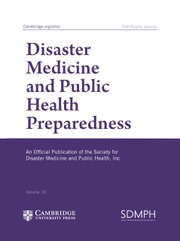No CrossRef data available.
Article contents
Trauma Level of Midwifery Students After the Catastrophe of the Century Turkey Earthquake: A Cross-Sectional Descriptive Study
Published online by Cambridge University Press: 02 April 2025
Abstract
Earthquakes deeply affect people’s lives and cause significant psychological damage. This study was conducted to determine the trauma level of midwifery students after the devastating earthquake in Turkey.
A descriptive cross-sectional study was conducted with 252 students enrolled in the midwifery department of the Faculty of Health Sciences of a state university in Turkey. Data were collected using the participant information form and the Scale for Determining the Level of Post-Earthquake Trauma. Kruskal-Wallis and Mann-Whitney U tests were used for data analysis.
This study found that post-earthquake, students had trauma levels and sub-dimension scores related to behavioral problems, excitement limitation, affective and cognitive structuring, and sleep problems that were above average. The research revealed that students who were present in one of the earthquake-affected provinces, experienced house destruction, suffered the loss of relatives, had previous traumatic events, or received disaster management training had significantly higher levels of trauma.
In this direction, it is of utmost importance for university students in midwifery departments to be prepared for natural disasters like earthquakes. This preparedness will enable them to effectively cope with the physical and psychological issues caused by such disasters, benefiting both their own health and public health.
- Type
- Original Research
- Information
- Copyright
- © The Author(s), 2025. Published by Cambridge University Press on behalf of Society for Disaster Medicine and Public Health, Inc


